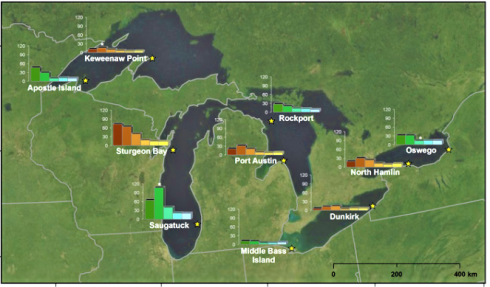A huge mistake? The European Commission will formalise on 12 December Monday’s decision by member states to renew for five years the licence for the herbicide glyphosate.
Weasel words in the FT last week:
 “Although the World Health Organization last year said the herbicide was “probably carcinogenic”, the latest joint assessment by UN agencies concludes there is no risk to humans from exposure through the diet” – implying that evidence shows that the use of the herbicide is risk free.
“Although the World Health Organization last year said the herbicide was “probably carcinogenic”, the latest joint assessment by UN agencies concludes there is no risk to humans from exposure through the diet” – implying that evidence shows that the use of the herbicide is risk free.
In May last year, the UN agencies said:
“The overall weight of evidence indicates that administration of glyphosate and its formulation products at doses as high as 2000 mg/kg body weight by the oral route, the route most relevant to human dietary exposure, was not associated with genotoxic effects in an overwhelming majority of studies conducted in mammals, a model considered to be appropriate for assessing genotoxic risks to humans. The meeting concluded that glyphosate is unlikely to be genotoxic at anticipated dietary exposures” (emphasis added).

Dr Christopher Connolly, a reader in neurobiology at the University of Dundee, said in an article in the Science Media Centre journal: “The evidence on the risk to human health from glyphosate is highly controversial, making it difficult for politicians to make a sound science-based decision. It is alarming that it is so ubiquitous that it is found commonly in human urine. We must make the next five years count, so that an evidence-based decision may be made at the end of this period.
Prof. David Coggon, Professor of Occupational and Environmental Medicine at the University of Southampton, said:
“IARC classified glyphosate as probably having the potential to cause cancer in humans. This was based on evidence of carcinogenicity in animals and suggestions of an association with lymphoma in exposed people (mainly agricultural workers, landscapers, nursery workers and home gardeners).
Cancer incidence among glyphosate-exposed pesticide applicators in the Agricultural Health Study (2005)
Summary:
We evaluated associations between glyphosate exposure and cancer incidence in the Agricultural Health Study (AHS), a prospective cohort study of 57,311 licensed pesticide applicators in Iowa and North Carolina. There was a suggested association with multiple myeloma incidence (a type of bone marrow cancer) that should be followed up as more cases occur in the AHS. Given the widespread use of glyphosate, future analyses of the AHS will allow further examination of long-term health effects, including less common cancers.
The World Health Organization’s International Agency for Research on Cancer in March 2015 said that glyphosate is “probably carcinogenic to humans” (PDF), adding “The evidence in humans is from studies of exposures, mostly agricultural, in the USA, Canada, and Sweden published since 2001”.
The latest news was reported by CNN in May this year, opening with story of Christine Sheppard
For 12 years, she had no idea what might have caused her non-Hodgkin’s lymphoma — until the IARC reported that glyphosate, the key ingredient in the weed killer Roundup, is probably carcinogenic. Roundup is the herbicide she sprayed on her coffee farm in Hawaii for five years.
That report spurred hundreds of non-Hodgkin’s lymphoma patients to sue Monsanto. Timothy Litzenburg’s law firm represents more than 500 of them. He said most of the patients didn’t know about a possible link between Roundup and non-Hodgkin’s lymphoma until the report came out.
Other companies also sell products containing glyphosate, why target Monsanto?
Litzenburg points out that Monsanto invented Roundup, they held the patent for many years, they are the EPA registrant for glyphosate, and they continue to dominate the market, adding:
“We are not alleging that our clients got cancer from glyphosate alone. We are suing because our clients got cancer from Roundup. … Roundup contains animal fats and other ingredients that increase the carcinogenicity of the glyphosate.”
Though UN agencies concluded that as yet no risk to humans from exposure through diet has been found, studies find that workers and gardeners using Roundup risk contracting non-Hodgkin’s lymphoma and multiple myeloma (a type of bone marrow cancer) – surely sufficient reason to withdraw the herbicide from use.
Media reports, including by EUobserver and Dutch magazine OneWorld, have shown that Efsa conclusions on the safety of glyphosate were partially based on scientific evidence provided by Monsanto, Roundup’s manufacturer. On 19 October, also the European Parliament expressed doubts over the scientific evaluations of glyphosate carried out by the European agencies.
Despite these findings, the European Commission will formalise on 12 December a decision by member states to renew the licence for the herbicide glyphosate for five years: https://euobserver.com/environment/140065.
Will Brexit give people in this country the opportunity to denounce the use of this and other dangerous substances and technologies and bring about beneficial change?
m
Tags: Agricultural Health Study, Brexit, Carcinogen, Dr Christopher Connolly, EC, multiple myeloma, non-Hodgkin’s lymphoma, Prof. David Coggon, UN agencies, WHO















Recent Comments